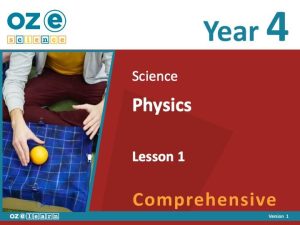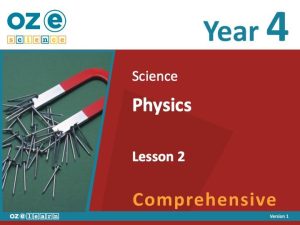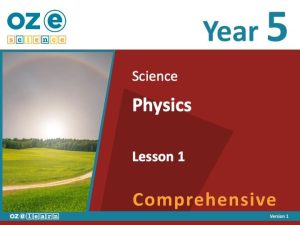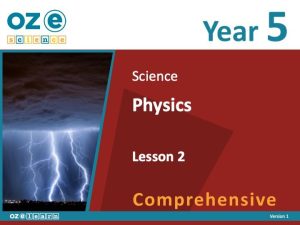Oz-e-science
Physics Comprehensive Years F–6
Oz-e-science Physics Comprehensive Year units align to the Australian Curriculum Content Descriptions
Free Starter Lessons
Year Overview
Year 4
Australian Curriculum Content Descriptions
Overview
Physics Comprehensive Year 4 is a Physical Sciences curriculum program for Year 4 students. It aligns to the Australian Curriculum Science Understanding:
- Forces can be exerted by one object on another through direct contact or from a distance (ACSSU076)
Note: This curriculum program is currently being updated to align with the Australian Curriculum 9.0, updated versions will be released in early 2024.
Learning Objectives
In Lessons 1 to 15, students learn about:
- what a force is and identify some common examples of forces in our everyday lives
- identifying different types of forces and explain the difference between contact and non-contact forces
- how to describe the ways forces can push and pull objects, causing them to move or stop moving
- how forces can make objects speed up and slow down
- how forces can resist objects when they are moving
- how forces can stretch objects and what happens when that force is released
- how forces can repel two objects away from each other or attract two objects closer to each other
- the force of gravity and how it affects objects of different shapes and sizes
- how size and direction of forces can move and change objects
- Sir Isaac Newton and his First Law of Forces
- Newton’s Second Law of Motion
- Newton’s Third Law of Motion
- using the Scientific Method to investigate Newton’s laws
- using the Scientific Method to evaluate and communicate the results of the experiment
Success Criteria
- Describe what a force is.
- Identify some common examples of forces.
- Explain what happens to an object when a force acts on it.
- Identify contact and non-contact forces.
- Explain what happens to objects when contact and non-contact forces act on them.
- Identify the forces used in pushing and pulling objects.
- Investigate motion by experimenting with pushing and pulling objects.
- Identify the forces used in speeding up and slowing down objects.
- Explain what acceleration and deceleration are.
- Investigate motion by experimenting with speeding up and slowing down objects.
- Identify the forces that can resist an object’s movement.
- Explain what friction and resistance are.
- Investigate friction by experimenting with objects moving.
- Identify the forces that can stretch objects.
- Explain what being elastic means.
- Investigate stretch by experimenting with applying force to objects.
- Identify the forces that can attract and repel objects.
- Explain what magnetic fields are.
- Investigate attracting and repelling by experimenting with magnets.
- Explain what gravity is.
- Describe how gravity works.
- Investigate gravity by experimenting with objects falling.
- Compare the size and direction of forces.
- Describe what happens to an object experiencing more than one force.
- Investigate forces by creating a marble rollercoaster.
- Explain who Isaac Newton is.
- Describe what Newton’s First Law is.
- Investigate Newton’s First Law by experimenting with moving objects.
- Explain Newton’s Second Law of Motion.
- Describe what mass is.
- Investigate Newton’s Second Law by experimenting with falling objects.
- Explain Newton’s Third Law of Motion.
- Describe what a force pair is.
- Investigate Newton’s Third Law by experimenting with pushing objects.
- Identify the steps in the Scientific Method.
- Experiment with Newtons laws using cars on a ramp.
- Measure the effect that steepness of a ramp has on forces.
- Create a scientific question.
- Create a hypothesis for an experiment.
- Predict the outcome of an experiment.
- Plan an experiment.
- Measure the effect that mass of an object has on forces.
- Evaluate the results of an experiment.
- Explain the findings using Newton’s laws.
- Communicate findings to the class.
Assessment
Progress Tests
Progress tests are conducted after every second lesson, allowing teachers to monitor student understanding of the concepts taught over the past two lessons and to identify where reteaching is needed. The Teaching Guide contains the testing questions, and the Student Workbook has a section where students write their answers and score themselves.
Structured Research Activity
The Structured Research Activity (SRA) for this unit is: Students plan and conduct an experiment to measure the effect that mass of an object has on forces and report findings to the class. The SRA takes place over two lessons so students can apply the Science Understanding and Science Inquiry Skills covered in the unit. Teachers use the Guide to Making Judgements, which is included in the Teaching Guide, to mark the SRA.
End-of-Unit Assessment
The last lesson is the end-of-unit assessment, which has a variety of question formats (e.g. label the diagram, circle the correct answer) to assess student mastery of content from the unit. The end-of-unit assessment is in the Teaching Guide. Teachers copy the assessment and distribute to students at testing time.
Explicit Instruction for Science
Oz-e-science uses a teaching approach and curriculum that uses explicit teaching of content knowledge of science and explicit teaching and practical scientific inquiry using the Scientific Method. Read more about pedagogy here.
Year 5
Australian Curriculum Content Descriptions
Overview
Physics Comprehensive Year 5 is a Physical Sciences curriculum program for Year 5 students. It aligns to the Australian Curriculum Science Understanding:
- Light from a source forms shadows and can be absorbed, reflected and refracted (ACSSU080).
Note: This curriculum program is currently being updated to align with the Australian Curriculum 9.0, updated versions will be released in early 2024.
Learning Objectives
In Lessons 1 to 15, students learn about:
- what a photon is, how they are created in the Sun’s core and how long they take to travel to the Sun’s surface
- how quickly photons can move through space
- how we can see light
- how light can pass through some materials and not others
- how a single ray of light can be bent and split into many different colours and directions
- colour being caused by light
- how astronomers use light to understand if stars and galaxies are moving towards or away from us
- how heavy objects can make lights path bend because of the force of gravity
- black holes and why there is no light around them
- what a laser is and how scientists use them to learn more about the universe
- how astrophysics has led to some famous discoveries about light and space
- using the Scientific Method to explain how scientists might investigate light
- how light is unique because it behaves both like a wave but also like a particle
- using the Scientific Method to investigate the way light travels
- evaluating and communicating their findings to the class.
Success Criteria
- Describe what a photon is.
- Explain how photons are created.
- Explain how photons make their way to the Sun’s surface.
- Describe the speed of light.
- Explain how the light we see today can be very old.
- Compare how long it takes light to reach us from different objects.
- Describe how we see light.
- Explain what a light reflection is.
- Compare how light reflects from different surfaces.
- Describe the terms transparent, opaque, translucent and absorption.
- Explain how density impacts the absorption of light.
- Compare how light is absorbed by different materials.
- Describe what happens to the path of light when it hits different objects.
- Explain what refraction is.
- Compare how light bends and splits using different materials.
- Describe how colour is made from light.
- Explain what the light spectrum is.
- Observe how light can be used to create colour.
- Describe how the colour of light changes when it moves towards or away from us.
- Explain the Doppler effect.
- Observe the Doppler effect using sound.
- Describe how objects are moved because of gravity.
- Explain how light can be bent by very large objects.
- Represent how light bends around a heavy object in space.
- Analyse how scientists first discovered black holes.
- Explain how and why black holes form.
- Represent how a black hole traps light.
- Explain what a laser is.
- Describe how scientists use lasers to map out the universe.
- Represent the mapping of the universe using a small laser.
- Explain what astrophysics is.
- Describe the tools and knowledge used in famous theories about space.
- Analyse the famous equation E=mc2
- Identify the steps of the Scientific Method.
- Experiment using the Scientific Method to explore light.
- Investigate materials to see how much light is let through.
- Explain how waves and particles move.
- Describe how we know light moves like both a wave and a particle.
- Analyse the famous light experiment that proves light moves like a particle.
- Create a scientific question.
- Create a hypothesis for an experiment.
- Predict the outcome of an experiment.
- Plan an experiment.
- Measure the patterns made by light to determine if it is moving like a wave or a particle.
- Evaluate the results of an experiment.
- Explain the findings using the wave theory of light.
- Communicate findings to the class.
Assessment
Progress Tests
Progress tests are conducted after every second lesson, allowing teachers to monitor student understanding of the concepts taught over the past two lessons and to identify where reteaching is needed. The Teaching Guide contains the testing questions, and the Student Workbook has a section where students write their answers and score themselves.
Structured Research Activity
The Structured Research Activity (SRA) for this unit is: Students use the Scientific Method to investigate the way light travels and report their findings to the class. The SRA takes place over two lessons so students can apply the Science Understanding and Science Inquiry Skills covered in the unit. Teachers use the Guide to Making Judgements, which is included in the Teaching Guide, to mark the SRA.
End-of-Unit Assessment
The last lesson is the end-of-unit assessment, which has a variety of question formats (e.g. label the diagram, circle the correct answer) to assess student mastery of content from the unit. The end-of-unit assessment is in the Teaching Guide. Teachers copy the assessment and distribute to students at testing time.
Explicit Instruction for Science
Oz-e-science uses a teaching approach and curriculum that uses explicit teaching of content knowledge of science and explicit teaching and practical scientific inquiry using the Scientific Method. Read more about pedagogy here.
Year 6
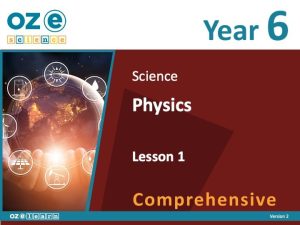
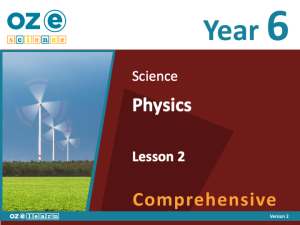
Teaching Resources
Extra resources
Australian Curriculum Content Descriptions
Overview
Physics Comprehensive Year 6 is a Physical Sciences curriculum program combining explicit instruction pedagogy and alignment to the Australian Curriculum Science Understanding:
- Electrical energy can be transferred and transformed in electrical circuits and can be generated from a range of sources. (ACSSU097)
Note: This curriculum program is currently being updated to align with the Australian Curriculum 9.0, updated versions will be released in early 2024.
Learning Objectives
In Lessons 1 to 15, students learn about:
- the different types of energy
- how energy can be transferred from one place to another
- how one kind of energy can be transformed into a different kind of energy
- electrical energy and the scientists who added to our knowledge of it
- electric currents and static electricity
- conductors and insulators
- the parts that make up an electrical circuit
- electrical diagrams
- four common sources of energy that are transformed to generate electrical energy
- fossil fuels as sources of energy that are transformed to generate electrical energy
- nuclear energy as a source of energy that is transformed to generate electrical energy
- renewable energy sources that are transformed to generate electrical energy
- investigating which renewable energy source would be best for their town
- how to analyse and evaluate their research to find out which renewable energy source would be best for their town
- presenting their findings about which renewable energy source would be the best for their town.
Success Criteria
- Explain what energy is.
- Describe six different types of energy.
- Observe energy forms in the school.
- Describe examples of how energy is transferred.
- Represent energy transfer using everyday items.
- Describe examples of how energy is transformed.
- Sort examples of energy transfer and transformation in a card game.
- Explain how electrical energy is generated.
- Describe how four scientists added to our understanding of electrical energy.
- Investigate how to generate electrical energy using a fruit battery.
- Explain how electrical energy moves as static electricity.
- Explain how electrical energy moves as an electric current.
- Investigate the effect of static electricity on different objects.
- Explain what makes a material a conductor or an insulator.
- Identify materials as insulators or conductors using a simple circuit.
- Explain what an electrical circuit is.
- Identify a complete circuit.
- Build a simple circuit.
- Explain what electrical diagrams are used for.
- Describe the different symbols used in electrical diagrams.
- Represent a circuit with a labelled diagram.
- Identify four common sources of energy that are transformed to generate electrical energy.
- Investigate different types of energy used to power a model car.
- Identify three fossil fuels that are used to generate electrical energy.
- Explain how fossil fuels contribute to climate change.
- Investigate which countries use the most energy generated from fossil fuels.
- Identify the sources of nuclear energy that are transformed to generate electrical energy.
- Explain the advantages and disadvantages of using nuclear energy to generate electricity.
- Identify the sources of renewable energy that are transformed to generate electrical energy.
- Explain the advantages and disadvantages of using renewable energy to general electricity.
- Represent the advantages of renewable energy on a poster.
- Ask scientific questions.
- Conduct research to understand which renewable energy sources might be best for the town.
- Analyse and evaluate the results of the research.
- Form a hypothesis about which renewable energy to use in the town.
- Communicate which renewable energy they would use in their town.
Assessment
Progress Tests
Progress tests are conducted after every second lesson, allowing teachers to monitor student understanding of the concepts taught over the past two lessons and to identify where reteaching is needed. The Teaching Guide contains the testing questions, and the Student Workbook has a section where students write their answers and score themselves.
Structured Research Activity
The Structured Research Activity (SRA) for this unit is: Students investigate renewable energy sources, identifying which source would be best for their town and presenting their findings to the class. The SRA takes place over two lessons so students can apply the Science Understanding and Science Inquiry Skills covered in the unit. Teachers use the Guide to Making Judgements, which is included in the Teaching Guide, to mark the SRA.
End-of-Unit Assessment
The last lesson is the end-of-unit assessment, which has a variety of question formats (e.g. label the diagram, circle the correct answer) to assess student mastery of content from the unit. The end-of-unit assessment is in the Teaching Guide. Teachers copy the assessment and distribute to students at testing time.
Explicit Instruction for Science
Oz-e-science uses a teaching approach and curriculum that uses explicit teaching of content knowledge of science and explicit teaching and practical scientific inquiry using the Scientific Method. Read more about pedagogy here.
Other Units
Lesson Design
Lesson Objective
Success Criteria
Activating Prior Knowledge
I Do
We Do
Apple Question
You Do
Revise
Professional Learning


